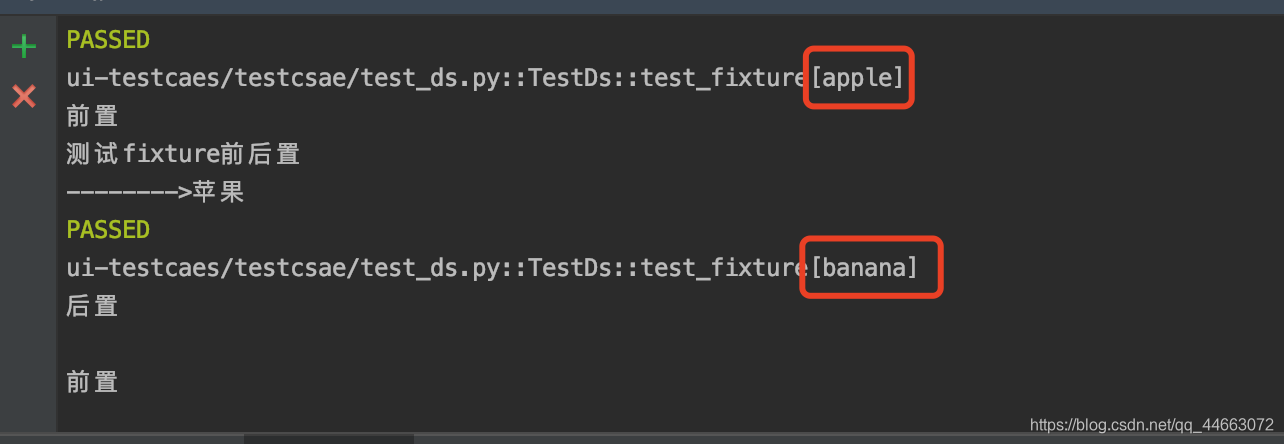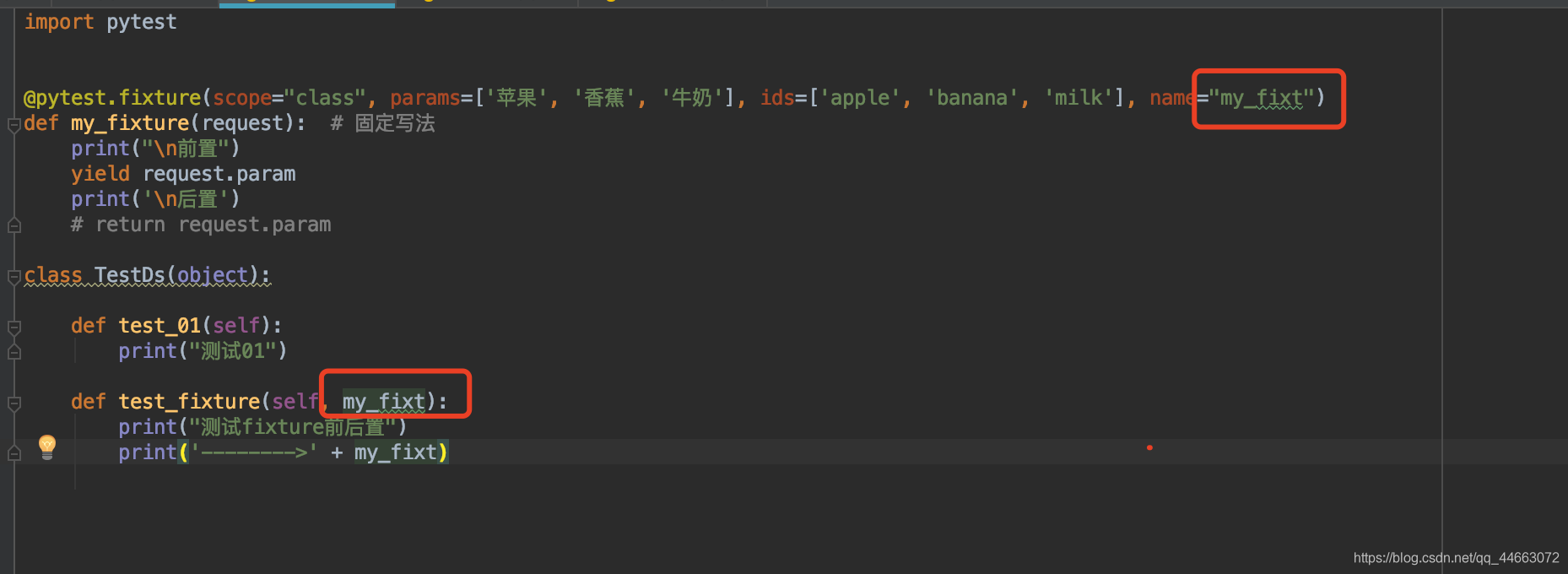一、@pytest.fixture()的5个参数含义
@pytest.fixture(scope="", params="", autouse="", ids="", name="")
- scope:表示被@pytest.fixture()方法标记的作用域。functions(默认)、class、moudle、package/session
- params:参数化(支持,列表,元组,字典列表[{},{},{}],字典元组({},{},{}) )
- autouse=True:自动执行,默认False
- ids:参数化时,给每一个值设置一个变量名,意义不大
- name:给@pytest.fixture()标记的方法取一个别名
二、初级用法-前后置
步骤一:定义fixture函数(函数名不固定);
步骤二:将函数名作为参数写入用例方法;
yield作用:带有yield的函数是一个迭代器,函数返回某个值时,会停留在某个位置,返回函数值后,会在前面停留的位置继续执行,直到程序结束
import pytest
@pytest.fixture(scope="function")
def my_fixture():`在这里插入代码片`
print("\n这是用例前置")
yield
print("\n这是用例后置")
class TestDs(object):
def test_01(self):
print("测试01")
def test_fixture(self, my_fixture):
print("测试fixture前后置")
运行结果:
ui-testcaes/testcsae/test_ds.py::TestDs::test_01 测试01
PASSED
ui-testcaes/testcsae/test_ds.py::TestDs::test_fixture
这是用例前置
测试fixture前后置
PASSED
这是用例后置
------------------------------------------- generated html file: file:///Users/dongshuai/PycharmProjects/pytest/ui-testcaes/output/report/report.html -------------------------------------------
======================================================================================= 2 passed in 0.02s =======================================================================================
二、前后置-autouse=Ture
autouse=True:自动执行,默认False,开启为True后,将不需要主动调用也能使用
比setup 和 teardown更好用,更灵活
import pytest
@pytest.fixture(scope="function", autouse=True)
def my_fixture():
print("\n这是用例前置")
yield
print("\n这是用例后置")
class TestDs(object):
def test_01(self):
print("测试01")
def test_fixture(self):
print("测试fixture前后置")
执行结果:
ui-testcaes/testcsae/test_ds.py::TestDs::test_01
这是用例前置
测试01
PASSED
这是用例后置
ui-testcaes/testcsae/test_ds.py::TestDs::test_fixture
这是用例前置
测试fixture前后置
PASSED
这是用例后置
------------------------------------------- generated html file: file:///Users/dongshuai/PycharmProjects/pytest/ui-testcaes/output/report/report.html -------------------------------------------
======================================================================================= 2 passed in 0.02s =======================================================================================
三、修改scope=“class”,在类的前后置
(module、package/session 原理同)
import pytest
@pytest.fixture(scope="class", autouse=True)
def my_fixture():
print("\n这是用例前置")
yield
print("\n这是用例后置")
class TestDs(object):
def test_01(self):
print("测试01")
def test_fixture(self):
print("测试fixture前后置")
执行结果:
ui-testcaes/testcsae/test_ds.py::TestDs::test_01
这是用例前置
测试01
PASSED
ui-testcaes/testcsae/test_ds.py::TestDs::test_fixture 测试fixture前后置
PASSED
这是用例后置
------------------------------------------- generated html file: file:///Users/dongshuai/PycharmProjects/pytest/ui-testcaes/output/report/report.html -------------------------------------------
======================================================================================= 2 passed in 0.03s =======================================================================================
(base) dongshuai@dongshuaideMacBook-Air pytest %
四、参数params的使用
params:参数化(支持,列表,元组,字典列表[{},{},{}],字典元组({},{},{}) )
**固定写法:**原理:params将参数遍历依次传给request,然后再传入添加该fixture的用例函数
该写法是固定的
import pytest
@pytest.fixture(scope="class", params=['苹果', '香蕉', '牛奶']) # 参数名,有s
def my_fixture(request): # 固定写法
return request.param # 属性,没有s
class TestDs(object):
def test_01(self):
print("测试01")
def test_fixture(self, my_fixture):
print("测试fixture前后置")
print('-------->' + my_fixture)
执行结果:
ui-testcaes/testcsae/test_ds.py::TestDs::test_01 测试01
PASSED
ui-testcaes/testcsae/test_ds.py::TestDs::test_fixture[\u82f9\u679c] 测试fixture前后置
-------->苹果
PASSED
ui-testcaes/testcsae/test_ds.py::TestDs::test_fixture[\u9999\u8549] 测试fixture前后置
-------->香蕉
PASSED
ui-testcaes/testcsae/test_ds.py::TestDs::test_fixture[\u725b\u5976] 测试fixture前后置
-------->牛奶
PASSED
------------------------------------------- generated html file: file:///Users/dongshuai/PycharmProjects/pytest/ui-testcaes/output/report/report.html -------------------------------------------
======================================================================================= 4 passed in 0.02s =======================================================================================
(base) dongshuai@dongshuaideMacBook-Air pytest %
五、使用ids给每个参数设置变量
ids:参数化时,给每一个值设置一个变量名,意义不大
import pytest
@pytest.fixture(scope="class", params=['苹果', '香蕉', '牛奶'], ids=['apple', 'banana', 'milk'])
def my_fixture(request): # 固定写法
print("\n前置")
yield request.param
print('\n后置')
# return request.param
class TestDs(object):
def test_01(self):
print("测试01")
def test_fixture(self, my_fixture):
print("测试fixture前后置")
print('-------->' + my_fixture)
执行结果:可以看见原来的中文unicode编码,变为了ids定义的变量名

六、name-给标记的方法起个别名(意义不大)
起别名后,本身的方法名不能使用

七、实际工作场景中如何使用
通过conftest.py 和 @pytest.fixture() 结合使用,实现全局的前置应用(比如:项目的全局登录,模块的全局处理)
- conftest.py 文件是单独存放的一个夹具配置文件,名称是不能更改。
- 作用:可以在不同的py文件中使用同一个fixture函数
- 原则上conftest.py 和需要运行的用例放到同一层,并且不需要做任何import导入操作


输出:
ui-testcaes/testcsae/user/test_ds.py::TestDs::test_02[\u661f\u661f]
全局--前置
user--前置
测试02
PASSED
user--后置
全局--后置
------------------------------------------- generated html file: file:///Users/dongshuai/PycharmProjects/pytest/ui-testcaes/output/report/report.html -------------------------------------------
======================================================================================= 5 passed in 0.03s =======================================================================================
总结:
- setup/teardown,setup_clas/teardown_class 它是作用于所有用例或者所有类
- @pytest.fixture() 它的作用是既可以部分也可以全部前后置
- conftest.py 和 @pytest.fixtrue()适合使用,作用于全局的前后置